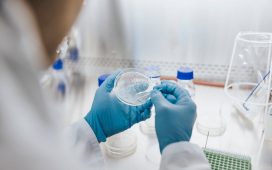Scientists in many fields received little recognition for the last couple of years, as the world focused on the emergency push to develop vaccines and treatments for Covid-19. But that doesn’t mean they weren’t still busy researching a dizzying series of developments that are now being reported as major discoveries and achievements.
1. Finding the root cause of lupus
Scientists have discovered a cause of lupus and a possible way to reverse it. A study published in the journal Nature points to abnormalities in the immune system of lupus patients that is caused by a molecular abnormality. “What we found was this fundamental imbalance in the types of T cells that patients with lupus make,” Deepak Rao, one of the study authors, said to NBC News. Specifically, “people with lupus have too much of a particular T cell associated with damage in healthy cells and too little of another T cell associated with repair,” NBC News said.
The good news is that this could be reversed. A protein called interferon is mainly to blame for the T-cell imbalance. Too much interferon blocks another protein called the aryl hydrocarbon receptor, which helps regulate how the body responds to bacteria or environmental pollutants. In turn, too many T-cells are produced that attack the body itself. “The study found that giving people with lupus anifrolumab, a drug that blocks interferon, prevented the T-cell imbalance that likely leads to the disease,” said NBC News.
Sign up for The Week’s Free Newsletters
From our morning news briefing to a weekly Good News Newsletter, get the best of The Week delivered directly to your inbox.
From our morning news briefing to a weekly Good News Newsletter, get the best of The Week delivered directly to your inbox.
2. Restoring brain cells
Scientists have found a way to repair brain cells impaired by a rare genetic disorder. A study published in the journal Nature found that a drug called antisense oligonucleotide allowed human neurons to develop normally despite carrying a mutation due to a genetic disorder called Timothy syndrome. “It’s the beginning of a new era for many of these diseases that we first thought were untreatable,” Dr. Huda Zoghbi, a professor at Baylor College of Medicine, said to NPR.
Timothy syndrome is caused by a mutation of a single gene in a person’s DNA. The new drug develops an “antisense nucleotide, a small piece of synthetic genetic material that alters the proteins made by a cell,” said NPR. The antisense nucleotide for Timothy syndrome was designed to replace a defective protein with a healthy version — “in effect counteracting the mutation responsible for the disorder.” This same approach could potentially be used to treat other genetic disorders, “including some that cause schizophrenia, epilepsy, ADHD and autism spectrum disorder.”
3. Menstrual blood as a diagnostic tool
Menstrual blood can potentially be used to measure blood sugar. In early 2024, the U.S. Food and Drug Administration (FDA) approved a new diagnostic menstrual pad called the Q-Pad and A1C Test by the biotechnology research company Qvin. The Q-Pad is an organic cotton period pad that “collects the blood, which a laboratory then uses to analyze the individual’s average blood sugar over three weeks through the A1C biomarker,” said Forbes.
“There is a lot of clinically relevant information in this bodily fluid that comes every month,” Sara Naseri, the CEO and co-founder of Qvin, said to Axios. “We’ve built a way for women to get insights about their health regularly. Non-invasively, using blood that comes every month, the menstrual blood.” Diagnostic capabilities can potentially be extended to diagnose HPV or endometriosis.
4. Cell therapy for melanoma
The U.S. Food and Drug Administration (FDA) approved the first cellular therapy for aggressive forms of melanoma. The treatment, called Amtagvi, is “designed to fight off advanced forms of melanoma by extracting and replicating T cells derived from a patient’s tumor,” said NPR. These cells are also called tumor-infiltrating lymphocytes (TIL). T cells are integral in the immune system but can become “dysfunctional inside tumors.”
“The approval of Amtagvi represents the culmination of scientific and clinical research efforts leading to a novel T cell immunotherapy for patients with limited treatment options,” Dr. Peter Marks, the director of the FDA’s Center for Biologics Evaluation and Research, said in a statement. The treatment won’t work for everyone, but research by the National Institutes of Health showed a “56% response rate among patients with melanoma, and 24% of patients had a complete disappearance of their melanoma, regardless of where it was,” Axios said. “This is the tip of the iceberg of what TIL can bring to the future of medicine,” Patrick Hwu, CEO of Moffitt Cancer Center, said to Axios.
5. Rhino IVF
Scientists were able to impregnate a southern white rhino using in-vitro fertilization (IVF). Researchers in Kenya implanted a southern white rhino embryo into another of the same species using the technique in September 2023, resulting in a successful pregnancy. The technique could be used to save the northern white rhino from total extinction. “We achieved together something which was not believed to be possible,” Thomas Hildebrandt, head of the reproduction management department at the Leibniz Institute for Zoo and Wildlife Research, said in a press conference.
There are two species of white rhinos: northern and southern. The northern white rhino is on the verge of extinction due to poaching, with only two females remaining. Luckily, scientists have sperm preserved from the last male rhino, which could be combined with an egg from the female and implanted into a southern white rhino female to act as a surrogate. Using a white rhino embryo to test the procedure was a “proof of concept” which is a “milestone to allow us to produce northern white rhino calves in the next two, two and a half years,” Hildebrandt said.
6. Pristine configuration
Scientists discovered six exoplanets that revolve around a star in a rare pattern called orbital resonance, said a study published in the journal Nature. This means that “for every six orbits completed by planet b, the closest planet to the star, the outermost planet g completes one,” CNN said, adding that “as planet c makes three revolutions around the star, planet d does two, and when planet e completes four orbits, planet f does three.”
The system was deemed a “rare fossil” by Rafael Luque, a postdoctoral scholar in the University of Chicago’s Department of Astronomy and Astrophysics. “We think only about one percent of all systems stay in resonance,” Luque said in a statement. “It shows us the pristine configuration of a planetary system that has survived untouched.” The discovery could help further the study of sub-Neptunes, which are planets larger than Earth but smaller than Neptune. They are not present in our solar system. “There is little agreement among astronomers about how these planets form and what they’re made of — so an entire system consisting of sub-Neptunes could help scientists determine more about their origin,” Luque said.
7. Restoring reefs
Coral bleaching has been a rapidly growing problem as climate change worsens. Without intervention, the reefs will continue to deteriorate. To counter this, scientists have explored the idea of a “coral gym,” essentially a “laboratory to make corals stronger,” NPR said. The goal is to “train” coral to survive more extreme conditions.
Warming oceans and rising temperatures are the largest contributors to coral degradation. “One of the things that we do in this lab is subject them to different environmental conditions and evaluate who’s a little bit stronger,” Ian Enochs, lead of the Coral Program at the Atlantic Oceanographic and Meteorological Laboratory at the National Oceanic and Atmospheric Administration, said to NPR. Researchers created a “complex matrix of aquariums” where they can “subject different types of corals to different environments and not only understand how they might survive, but perhaps help them to do so.”
8. AI to find aliens
Scientists have created an artificial intelligence model that can detect alien life, said a study published in the journal PNAS. The algorithm can “distinguish between samples of biological and nonbiological origin 90% of the time,” after being “trained using living cells, fossils, meteorites and lab-made chemicals,” Live Science said. “Put another way, the method should be able to detect alien biochemistries, as well as Earth life,” Robert Hazen, co-author of the study, said in a statement.
The AI “does not involve a machine having to look for specific things,” but rather “looks for differences between samples,” BBC said. “These results mean that we may be able to find a lifeform from another planet, another biosphere, even if it is very different from the life we know on Earth,” Hazen said. “And, if we do find signs of life elsewhere, we can tell if life on Earth and other planets derived from a common or different origin.”
9. Inverse vaccines
Scientists may have found a way to calm immune responses for those with autoimmune disorders using an “inverse vaccine,” said a study published in the journal Nature Biomedical Engineering. The immune system responds to specific identifying markers on invaders like viruses and bacteria called antigens, “but some immune cells react to self-antigens,” which are “molecules from our own cells,” said Science. “In autoimmune diseases, these misguided immune cells turn against patients’ own tissues.”
The new research worked by “directing potential self-antigens to the liver,” where “immune cells there pick up self-antigens and then stifle T cells that could target these molecules.” The experiment was performed on mice. “The method they use is promising and potentially can induce better tolerance,” neurologist and neuroimmunologist A.M. Rostami said to Science, adding that “we don’t know” whether this approach is “applicable to human disease in which we don’t know the antigen.”
10. Sequencing the Y-chromosome
Scientists have finally sequenced the entire Y chromosome, one of the human sex chromosomes present in those assigned male at birth. The feat has been “notoriously difficult” because of the Y chromosome’s “complex repeat structure,” said a research paper published in the journal Nature.
“Just a few years ago, half of the human Y chromosome was missing” from knowledge of the human genome, Monika Cechova, co-lead author on the paper, said to CNN. “I would credit new sequencing technologies and computational methods for this,” Arang Rhie, who also worked on the paper, said to Reuters. The X chromosome was fully sequenced back in 2020.
Understanding the Y chromosome can help with a number of health issues, including fertility. Genes have also “been shown to be required for the prevention of cancer and cardiovascular disease,” Kenneth Walsh, a professor of biochemistry and molecular genetics at the University of Virginia School of Medicine, said to CNN.










